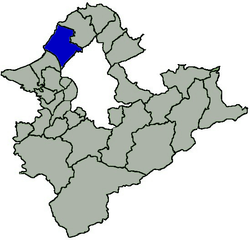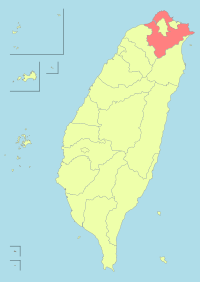Tamsui District
| Tamsui 淡水區 Danshui | |
|---|---|
| District | |
| Tamsui District | |
 | |
 Tamsui District in New Taipei City | |
| Coordinates: 25°00′40″N 121°26′45″E / 25.01111°N 121.44583°ECoordinates: 25°00′40″N 121°26′45″E / 25.01111°N 121.44583°E | |
| Country |
|
| Special municipality | New Taipei City |
| Population (January 2016) | |
| • Total | 162,441 |
| Time zone | +8 |
| Tamsui District | |||||||||||
| Traditional Chinese | 淡水區 | ||||||||||
|---|---|---|---|---|---|---|---|---|---|---|---|
| Simplified Chinese | 淡水区 | ||||||||||
| |||||||||||
| Alternative Chinese name | |||||||||||
| Chinese | 淡水 | ||||||||||
| Postal | Tamsui | ||||||||||
| |||||||||||
Tamsui[1] is a sea-side district in New Taipei City in northern Taiwan. It is named after the Tamsui River; the name means "fresh water". The town is popular as a site for viewing the sun setting into the Taiwan Strait. Though modest in size (population 162,441), the district is home to three universities (Aletheia University, Tamkang University, and St. John's University) and has a large role in Taiwanese culture.
Names
Historical
Originally settled by the Ketagalan aborigines, the location was called Hoba, meaning "stream's mouth". Hoba was loaned into Taiwanese as Hō͘-bé (滬尾), and historical works in English have referred to the place as "Hobe",[2] "Hobé",[3] or "Hobe Village".[4] The Spanish arrived in the 17th century and called this place Casidor and the Tamsui River Kimalon. Dutch records have used the placenames Tamsuy and Tampsui to refer to this area, but have also referred to another "Lower Tamsuy" in the south of the island.[5]
In his 1903 book The Island of Formosa, former US diplomat James W. Davidson related that the spelling and pronunciation of the placename 淡水 has been given in many variants by "as many so-called authorities. Tamsui, Tamshuy, Tamshui, Tamsoui, Tan-sui,...".[3] The first variant "Tamsui" is consistent with the literary Hokkien reading,[6] and (possibly by chance) is equal to its Church Romanization (Pe̍h-ōe-jī: Tām-súi) minus tone markings and hyphen. The variant "Tan-sui", with exception of the hyphen, is consistent with the romanization of Japanese. However, the first variant was apparently already well-known circa 1900,[7] and features prominently in two English-language maps of the same era.[8] Furthermore, at that time, the term "Tamsui" was used "in a most liberal way; it may mean the harbor, the river, the village of Hobe, Twatutia, or Banka, and it may mean the whole district."[9]
Modern
From 1950 until the 2010 creation of New Taipei City, Tamsui was officially "Tamsui urban township" (淡水鎮; Tām-súi-tìn; postal: Tamsui) in the former Taipei County. The variant "Danshui" (from pinyin: Dànshuǐ), formerly used officially by the Taiwan government, Taipei Metro, and other sources, is based on the Mandarin pronunciation. Meanwhile, the name "Tamsui" is based on the Taiwanese pronunciation. Having long used "Tamsui" as the official English name, the local government of the district informed the national government in 2011 that "Tamsui" rather than "Danshui" should be used in English.
History
Colonial period
The Spanish arrived in the area of Tamsui in the 17th century. In the fall of 1629, the Spanish established the first major non-aboriginal settlement comprising the town and mission of Santo Domingo. The Spanish occupied northern Taiwan for the purpose of securing Spanish interests in the Philippines against the Dutch (who were already established in the South of Taiwan by then), the British, and the Portuguese, as well as for facilitating trade with China and Japan.
In 1641, the Spanish were expelled from Taiwan by the Dutch. The Spanish had already abandoned their settlement in Tamsui in 1638 and the Dutch built a new fort which they named Fort Anthonio (after the Governor-General of the Dutch East India Company Anthonio van Diemen). It is today known as Angmo Siaa (Chinese: 紅毛城; Pe̍h-ōe-jī: Âng-mn̂g-siâⁿ; literally: "red-hair fortress") and is the main building of the Fort San Domingo museum complex. In addition to "pacifying" the aboriginal tribes in the area, the Dutch also encouraged the immigration and settlement of the area by Han Chinese, as well as expanding the production and trade of sulfur, animal skins, and other indigenous resources.
The Dutch left Fort Zeelandia in Taiwan in 1662 following their defeat by Koxinga at the Siege of Fort Zeelandia, who continued the policy of increasing Han Chinese immigration until the surrender of his grandson Zheng Keshuang to the Qing Dynasty in 1683. In 1668, the Dutch left Keelung after getting harassed by aboriginals from Tamsui.[10]
Because of its proximity to mainland China, as well as its location in a natural harbor, Tamsui quickly became a major fishing and trade port. The Qing naval patrol also established an outpost in Tamsui in 1808. In 1862, the Qing government opened Tamsui to foreign trade under the terms of the Treaty of Tientsin, exporting tea, camphor, sulfur, coal, opium, and dyes. By the mid-19th century Tamsui had become the largest port in Taiwan, boasting a sizable foreign population as well as a British consulate at Fort Santo Domingo.[11][12]

Canadian medical doctor and missionary George Leslie Mackay arrived in Tamsui on March 9, 1872, proceeding to establish Taiwan's first hospitals in Western medicine and formal educational facilities, including Oxford College (now part of Aletheia University), the oldest European-style higher-education institution in Taiwan by some measure.
During the Sino-French War the French attempted an invasion of Taiwan during the Keelung Campaign. Liu Mingchuan, who was leading the defence of Taiwan, recruited Aboriginals to serve alongside the Chinese soldiers in fighting against the French. The French were defeated at the Battle of Tamsui and the Qing forces pinned the French down at Keelung in an eight-month-long campaign before the French withdrew.
In 1884, the harbour of Tamsui was blockaded by the French Navy under the command of Admiral Amédée Courbet, during the Sino-French War.[13] The French were defeated at the Battle of Tamsui by the Chinese.
By the time Taiwan was ceded to Japan following the end of the Sino-Japanese War in 1895, Tamsui's position as a seaport was beginning to wane due to the accumulation of sediments in the Tamsui River. By the 20th century, most of Tamsui's port operations had moved to Keelung, and the local economy had switched primarily to agriculture. However, public infrastructure construction projects by the Japanese led to Tamsui's rise as a local administrative and cultural center.
In the early years of Japanese rule (1895-1945), the population of the city was nearly 6,000.[14] From 1920, under the prefecture system, Tamsui was called Tamsui Town (淡水街), and was governed under Tamsui District (淡水郡) of Taihoku Prefecture.
Contemporary history
Following the end of World War II, Tamsui reverted to being a small fishing town. With the expansion of nearby Taipei City, Tamsui slowly became a center for tourism along Taiwan's northwest coast. In the last ten years, the city has become popular as a suburb of Taipei in the local real estate market.
Following the completion of the Taipei Metro's Tamsui Line in 1997, the town experienced a sharp increase in tourist traffic, reflected in the completion of several riverside parks, the growth of open-air markets specializing in traditional handicrafts and street-stall snacks, the construction of a fisherman's wharf, and the increase in passenger ferries traversing across and along the river.
Education
Tourist attractions
- Drop of Water Memorial Hall
- Former British Merchant Warehouse
- Fort San Domingo
- Museum of Tamsui Fishiegoodies
- Tamsui Church
- Tamsui Customs Officers' Residence
- Tamsui Customs Wharf
- Tamsui Lover's Bridge
- Tamsui Meteorological Observatory
- Tamsui Old Street
- Teng Feng Fish Ball Museum
Transportation
Sister city
 - Chico, California (U.S.) 1985[15]
- Chico, California (U.S.) 1985[15]
Gallery
-

Tamsui/ Chen Cheng-po/ 1935/ 91 x 116.5 cm/ Collection from Taiwan Museum of Fine Arts
-

Tamsui/Tamsui Church/ Ni Chiang-huai/ 1936/ Paper/ Watercolor/ 49.5×66cm/ Collection of Taipei Museum of Fine Arts
-

Tamsui waterfront at sunset
-

A French sketch of Tamsui in 1893
-
The sunset in front of the Long Pier of Tamsui
-
The sunset in front by the Long Pier of Tamsui
Sources
- History section retrieved and translated from Tamsui District office website.
Notes
- ↑ common variants: Danshui, Tamshui (see Names)
- ↑ Davidson (1903), p. 310.
- 1 2 Davidson (1903), p. 261.
- ↑ Davidson (1903), p. 310 (illustration).
- ↑ Campbell, William (1903). "Explanatory Notes". Formosa under the Dutch: described from contemporary records, with explanatory notes and a bibliography of the island. London: Kegan Paul. p. 548. OCLC 644323041.
- ↑ the character for "water" 水 has two different readings: a literary reading (Pe̍h-ōe-jī: súi) and a colloquial reading (Pe̍h-ōe-jī: chúi). Incidentally the character for "clear" 淡 has a total of four readings. 臺灣閩南語常用詞辭典 [Taiwanese Hokkien Dictionary of Common Words] (in Chinese). Ministry of Education, R.O.C. 2011. Iûⁿ, Ún-giân. 台語線頂字典 [Taiwanese Online Character Dictionary].
- ↑ Davidson (1903), p. iii: "In later chapters describing the island under Japanese rule, and in the map, the Japanese name is given first, and the Chinese in brackets, with the exception of a few well-known names such as Kelung, Takow, etc., and some English names of islands in the Pescadores." (Note: "Tansui" is not found until the index and is absent from the map)
- ↑ see, for example:
- Campbell, William (August 1896). "The island of Formosa: Its past and future". Scottish Geographical Magazine 12 (8). map. doi:10.1080/00369229608732903.
- Davidson (1903), map
- ↑ Davidson (1903), p. 261: "The term Tamsui is used in a most liberal way; it may mean the harbor, the river, the village of Hobe, Twatutia, or Banka, and it may mean the whole district. Properly it is but the name of a river. A resident of Twatutia may likewise describe himself as a residient either of Twatutia, Taipehfu, or Tamsui, and still be quite correct so far as custom goes, although ordinarily the merchants and consuls, whether at Hobe or Twatutia, use Tamsui as their address."
- ↑ Shepherd 1993, p. 95.
- ↑ NEVILLE-HADLEY, PETER (2014). "Sleepy Tamsui Once a Thriving Treaty Port". Culture Locker. Meridian Writers’ Group.
- ↑ The consulate was closed on 13 March 1972 and returned to the authorities in 1980. See Sino-British relations.
- ↑ Elleman, Bruce A. (2001). Modern Chinese warfare, 1795-1989. Routledge. p. 89. ISBN 9780415214735.
Following this setback, the Qing court officially declared war on France on 26 August 1884. On 1 October, Admiral Courbet landed at Jilong with 2,250 men, and the city fell to the French. Chinese forces continued to encircle Jilong throughout the rest of the War. Although a French blockade thwarted all subsequent Chinese efforts to send a fleet to relieve Taiwan, the French troops never succeeded in taking the riverside town of Danshui (Tamsui) in Taiwan's northwestern coastal plain, immediately north of modern-day Taipei. As a result, French control over Taiwan was limited merely to the northern coast. China's central fleet, based in Jiangsu Province, proved unable to break through Admiral Courbet's blockade of Taiwan. Although the south quickly requested assistance from the northern fleet, Li Hongzhang refused to place his own ships in danger. This decision almost guaranteed that China's coastal waters would be dominated by the French.
- ↑ Takekoshi (1907), p. 200.
- ↑ Guo, Elizabeth; Kennedy, Brian (10 July 2008). "Tale of two towns : Chico, Calif., and Tamsui, Taiwan, have more in common than you might think". Chico News & Review. Retrieved 28 December 2014.
Bibliography
External links
| Wikimedia Commons has media related to Tamsui. |
- Tamsui District office website (Chinese version)
- Tamsui District office website (English version)
 Tamsui travel guide from Wikivoyage
Tamsui travel guide from Wikivoyage- Tamsui Historic Museum
- Takao Club: The Tamsui Foreign Cemetery
- Tamsui Forum
| ||||||||||||||||||||||||||||||||||
| ||||||||||||||||||||||||||||||||||||||||||||||

